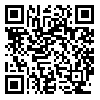Volume 4, Issue 1 (Summer 2018)
SJNMP 2018, 4(1): 62-70 |
Back to browse issues page
Download citation:
BibTeX | RIS | EndNote | Medlars | ProCite | Reference Manager | RefWorks
Send citation to:



BibTeX | RIS | EndNote | Medlars | ProCite | Reference Manager | RefWorks
Send citation to:
Maraki F, Ghadami A, Zarei M, Larti N. Surgical Safety Checklist: Documentation of Use of Electrocautery and Tourniquet Devices
. SJNMP 2018; 4 (1) :62-70
URL: http://sjnmp.muk.ac.ir/article-1-165-en.html
URL: http://sjnmp.muk.ac.ir/article-1-165-en.html
1- Isfahan University of Medical Sciences
2- Isfahan University of Medical Sciences ,surgicaltechnologist89@yahoo.com
2- Isfahan University of Medical Sciences ,
Abstract: (4280 Views)
Background & Aim: Documentation of cares is one of the responsibilities of operating room nurses. One of the possible patient damages caused during surgery is use of electrocautery and tourniquet devices. Despite the need for recording the performance of these devices, there is no specific part on surgery checklists dedicated to this issue. Therefore, this study aimed to change the safe surgery checklist through documenting the application of electrocautery and tourniquet devices.
Materials & Methods: This action research was conducted on 30 operating room nurses in Isfahan, Iran in 2017. The solution of choice was adding a researcher-made checklistto the operating room files in order to document the use of electrocautery and tourniquet devices for three months. In addition, a researcher-made survey on the status of operating room file documentation was filled by the subjects before and after the intervention. Moreover, data analysis was performed in SPSS version 22 using descriptive and analytical statistics.
Results : In this research, 28 out of 30 participants had a mean work experience of 11.87±8.30 years in operating rooms. Furthermore, there was a significantly higher frequency of positive response to the question of “Do you think that the checklist is useful?” after the intervention, compared to before the intervention (P<0.001). In total, 90% of the nurses agreed with adding the checklist to patient records, and 96.7% confirmed the effectiveness of the new checklist on decreased professional errors and patient damage.
Conclusion: According to the results of the study, the checklist of use ofelectrocautery and tourniquet devices was useful. It seems that full documentation can reduce the possibility of errors and provide a valid document for healthcare providers when faced with legal problems.
Materials & Methods: This action research was conducted on 30 operating room nurses in Isfahan, Iran in 2017. The solution of choice was adding a researcher-made checklist
Conclusion: According to the results of the study, the checklist of use of
Type of Study: Research |
Subject:
Special
Received: 2018/09/19 | Revised: 2019/06/30 | Accepted: 2018/09/28 | Published: 2019/10/24 | ePublished: 2019/10/24
Received: 2018/09/19 | Revised: 2019/06/30 | Accepted: 2018/09/28 | Published: 2019/10/24 | ePublished: 2019/10/24
References
1. Pillips N. Berry & Kohn's Operating Room Technique: Elsevier; 2017.
2. Sparkes D, Rylah B. The World Health Organization Surgical Safety Checklist. British Journal of Hospital Medicine (2005). 2010; 71(5): 276-80. [DOI:10.12968/hmed.2010.71.5.47908]
3. Rosenberg Nm, Urman Rd, Gallagher S, Stenglein J, Liu X, Shapiro Fe. Effect of an Office-Based Surgical Safety System on Patient Outcomes. Eplasty. 2012; 12:493-495.
4. Tiusanen Ts, Junttila K, Leinonen T, Salanterä S. The Validation of Aorn Recommended Practices in Finnish Perioperative Nursing Documentation. Aorn Journal. 2010; 91(2):236-47. [DOI:10.1016/j.aorn.2009.06.027]
5. Spruce L, Braswell Ml. Implementing Aorn Recommended Practices for Electrosurgery. Aorn Journal. 2012; 95(3):373-87. [DOI:10.1016/j.aorn.2011.12.018]
6. Saaiq M, Zaib S, Ahmad S. Electrocautery Burns: Experience with Three Cases and Review of Literature. Annals of Burns and Fire Disasters. 2012; 25(4):203-8.
7. Eder Sp. Guideline Implementation: Energy-Generating Devices, Part 1-Electrosurgery. Aorn Journal. 2017; 105(3):300-10. [DOI:10.1016/j.aorn.2017.01.004]
8. Hicks Rw, Denholm B. Implementing Aorn Recommended Practices for Care of Patients Undergoing Pneumatic Tourniquet-Assisted Procedures. Aorn Journal. 2013; 98(4):382-96. [DOI:10.1016/j.aorn.2013.08.004]
9. Lamont T, Watts F, Stanley J, Scarpello J, Panesar S. Reducing Risks of Tourniquets Left on After Finger and Toe Surgery: Summary of a Safety Report from the National Patient Safety Agency. Bmj. 2010; 340(7753):973-4. [DOI:10.1136/bmj.c1981]
10. Mingo-Robinet J, Castañeda-Cabrero C, Alvarez V, León Alonso-Cortés Jm, Monge-Casares E. Tourniquet-Related Iatrogenic Femoral Nerve Palsy after Knee Surgery: Case Report and Review of the Literature. Case Reports in Orthopedics. 2013; 201:1-4.. [DOI:10.1155/2013/368290]
11. Doosti-Irani M, Abdoli S, Parvizy S, Fatemi Ns. Overcoming Diabetes-Related Stigma in Iran: A Participatory Action Research. Applied Nursing Research. 2017; 36: 115-21.. [DOI:10.1016/j.apnr.2017.06.008]
12. Foglia Rp, Alder Ac, Ruiz G. Improving Perioperative Performance: The Use of Operations Management and the Electronic Health Record. Journal of Pediatric Surgery. 2013; 48(1):95-8. [DOI:10.1016/j.jpedsurg.2012.10.022]
13. Catchpole K. Errors in the Operating Theatre-How to Spot and Stop them. Journal of Health Services Research & Policy. 2010; 15(1_Suppl):48-51. [DOI:10.1258/jhsrp.2009.09s105]
14. Landers R. Reducing Surgical Errors: Implementing a Three-Hinge Approach to Success. Aorn Journal. 2015; 101(6):657-65. [DOI:10.1016/j.aorn.2015.04.013]
15. Stratton M. The Power of Checklists. Aorn Journal. 2016; 103(6):549-51. [DOI:10.1016/j.aorn.2016.04.013]
16. Fourcade A, Blache Jl, Grenier C, Et Al. Barriers to Staff Adoption of a Surgical Safety Checklist. Bmj Qual Saf 2012; 21(3):191-7. [DOI:10.1136/bmjqs-2011-000094]
17. De Vries En, Dijkstra L, Smorenburg Sm, Et Al. The Surgical Patient Safety System (Surpass) Checklist Optimizes Timing of Antibiotic Prophylaxis. Patient Safety in Surgery. 2010; 4(1):6-10 [DOI:10.1186/1754-9493-4-6]
Send email to the article author
| Rights and permissions | |
 |
This work is licensed under a Creative Commons Attribution-NonCommercial 4.0 International License. |






